by Sam Tackeff | Sep 26, 2010 | Asian, Books, Challenge, chicken, Filipino
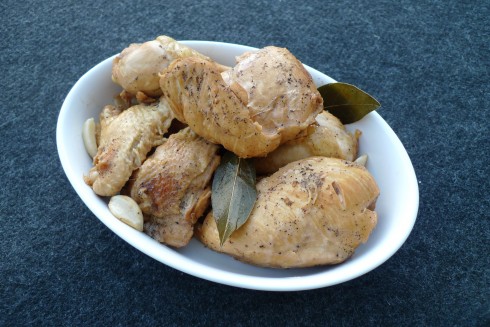
“Filipino food is delicious because it is cooked with love and always served with generosity and hospitality.”
One of the greatest pleasures of working at Omnivore Books is getting to learn about different cultural cuisines.
For the second Foodbuzz Next Food Blog Star assignment, we’ve been tasked to tackle a classic dish from another culture. My immediate thought: Chicken Adobo. Pungent, tasty, and shockingly easy to make, Adobo is a staple of Filipino cuisine.
Filipino food is finally getting its moment in the sun. In Los Angeles, good Filipino restaurants are ubiquitous and the younger generation are clamoring to embrace their cultural food roots. In New York, Amy Besa and Romy Dorotan created a sensation with their restaurant Cendrillon in Manhattan, and more recently moved out to Brooklyn to open the Purple Yam. Here in the Bay Area, Filipino restaurants are on the rise too, and food trucks Adobo Hobo, Hapa SF, and Senor Sisig are producing both contemporary and traditional versions of Filipino classics.
A few months ago, Filipino chef and cookbook author Amy Besa came for a talk at Omnivore Books. To be honest, having grown up in New Hampshire, I had never experienced true (or even bastardized) Filipino cuisine. While Besa spoke, I feverishly took notes.
In addition to being an incredibly warm and friendly woman, Besa is above all an intellectual. “If you are going to write a cookbook,” she elaborated, “I would recommend that you read a lot first. And use food to learn about history. If you try to trace back to where your food came from, you are doing history, and all of a sudden [history] is very exciting!”

(Photo: Allison Michael Orenstein, Time Out NY)
“Filipino food is fundamentally about balance, subtlety, nuance and harmony.”
People tend to itemize Filipino dishes rather than contextualize them. A good way to think about any cultural cuisine is to look at it from a historical perspective: food that is ours, and food that is borrowed. The Philippines experienced a long history of colonialism and occupation, and the food culture was greatly influenced over time. Besa noted that “Filipinos were very good at borrowing foods – the foods that they liked, they indigenized.”
Arab traders had been passing through for eons, and over several hundred years the Philippines were ruled by Spain, and then really ruled by Mexico. You can see this in influences such as Pampanga Bringhe – the Filipino version of Paella (made with sticky rice with coconut, turmeric, and native chicken.) There were very few influences from Mexico, but those include tamales made with rice, and other crossovers such as the use of lye.
Existing in Southeast Asia, they also had many influences from across the region. Immigrants from the Fujian mountains couldn’t use a lot of vegetable oils because they were cost prohibitive to the poor Fujian, so they used pork as fat, which was brought over to the Philippines. Then the Cantonese came with their cultural influences, and as richer communities they brought lighter foods such as stir fries.
In the 50’s, the United States came to occupy the country. Besa noted, regretfully, “Television came on in the 50’s and the big companies started cooking shows to promote their products (and in doing so destroyed generational culinary transfer).The new medium got totally divorced from the values of food you got from your grandmother.”
Besa made it her mission to preserve some of the old ways in her book “Memories of Philippine Kitchens“.
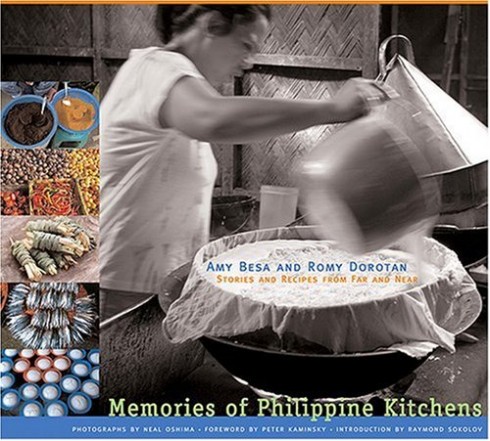
“No matter how rich or poor – Adobo is always on the table, and there are universal rules.”
In many Filipino dishes — including Adobo – a traditional marinade technique, Sinigang – a soup of meat or seafood with tropical fruits, and Kinilaw – a seafood preparation similar to ceviche — the common flavor is sourness. Besa explains this as defining the Filipino palate. The ingredients are the key to the culture, and “Every ingredient you put into your food has got to mean something”. In her restaurant, Besa imports coconut sap vinegar, heirloom rice, and salt from the Philippines. “Everytime I use heirloom rice, I eat up the price – it supports a farmer – that’s the taste of our soil. Of our culture. For me, that’s how I show my pride. It’s not always the best business model, but it is what makes us happy.”
When I set out to choose a recipe for Adobo, I thought about Amy’s rules for creating a recipe and the importance of dealing with ingredients and showing respect for the dish. A good recipe will explain how the dish came about into being, and what you are trying to do with it. You find a lot of truths in classic combinations. You use the very best ingredients.
There are endless combinations of Adobo recipes, but the key components are the sweet, sour, and slightly spicy flavors infused in the meat and vegetables. The technique has been native to the Philippines for centuries, and it was only after the Spaniards came that it was renamed. (Adobo is a Spanish word for the marinades in Spain and Mexico that slightly resembled the Filipino dish.)
For my version of a Filipino Adobo, I used chicken, soy sauce, rice vinegar, coconut milk, bay leaves, black peppers, and chiles. I made some modifications based on what was in my own kitchen (ie: low sodium soy sauce, and lite coconut milk), but the beauty of Adobo is that as long as you have that wonderful sour flavor from the vinegar, and the sweet coconut, it tends to turn out well every time.
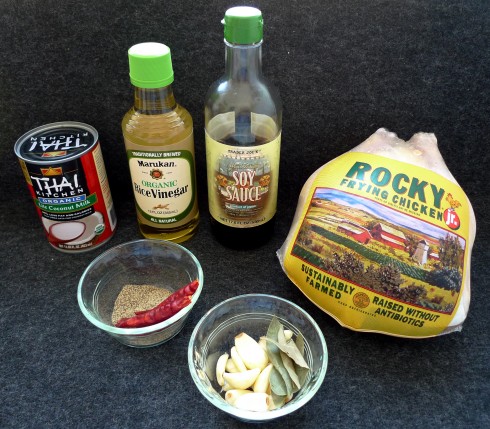
“Cookbooks are a roadmap to our identity, our history, and our roots.”
When Besa spoke about creating the cookbook, I immediately felt moved by her influences and how thoughtful she was about the process.
“I first had to make my cookbook really personal – my love of food comes from my grandmother. It’s a way of preserving memory. Ask a person who is dying about food memories. … Every family should record their treasured recipes…. In generations past, you knew where your food came from. Your Grandmother wouldn’t take shortcuts – it would be the best.
Her first rule of writing cookbooks is to find a muse. For her, it was Doreen Gamboa Fernandez – whose books led Amy to learn more about Filipino foods. She re-read them every year to make her understanding of Filipino food and culture deeper.
It took Amy and Romy four years to put together this book. They traveled back to the Philippines, where she hadn’t been since she had left Manila 30 years before, during a period of political unrest. She traversed the country taping oral histories. What’s your name? How do you do this? “[It is] amazing what you can discover. You become very attuned to the ingredients. The knowledge of the people [like being acutely aware of the stages of a coconut] – just amazing – once you accumulate all that information, you raise the level of information by seeing universalities of all things.”
At one point, an external editor tried to take it over. Besa was adamant: “You can not take out Mahjong. She wanted to cut out the personal. Her notes were kind of racist – too much about grannie, boring.”
For me, “Memories of Philippine Kitchens” has become one of my most treasured cookbooks on my shelf. The material was totally new to me, and I realized that there was so much to discover about my own food and cultural roots — it has inspired me to start writing my own food histories.
“If you really love and respect your culture and food, you would not come up with anything less than the best.”
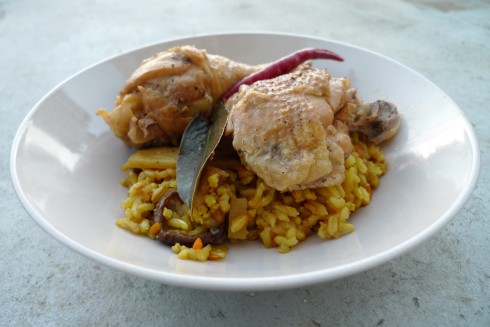
Chicken Adobo
Excerpted from Memories of Philippine Kitchens by Amy Besa and Romy Dorotan (Stewart, Tabori & Chang, 2006).
Serves 4 to 6
This is the recipe we use at the restaurant. The coconut milk helps keep the chicken moist and it makes a rich sauce. We serve this with Mushroom and Bamboo Shoot Rice (recipe follows) and sautéed mustard greens or bok choy. There are countless variations of chicken adobo; Mary “Inday” Gancayco serves a memorable mixture of chicken and pork adobo coated with mashed chicken livers and topped with fried garlic.
Marinade:
1 1/2 cups rice vinegar
1 cup coconut milk
1/4 cup soy sauce
12 garlic cloves, peeled
3 bay leaves
3 whole birdseye chiles
1 1/2 teaspoons freshly ground black pepper
One 3 1/2-pound whole chicken, quartered and cut into pieces
In a large nonreactive bowl or heavy-duty, resealable plastic bag, combine all of the marinade ingredients. Add the chicken pieces and turn to coat in the marinade. Refrigerate for at least 2 hours or overnight.
In a large casserole or Dutch oven, heat the chicken and marinade over high heat. Bring to a boil, then reduce the heat and simmer, stirring occasionally to make sure the chicken is covered in the marinade, until the chicken is cooked through and tender, 20 to 25 minutes.
Transfer the chicken pieces to a large bowl, raise the heat to medium-high, and reduce the sauce until it is the consistency of heavy cream, about 5 minutes. Remove the bay leaves and chiles. Return the chicken to the sauce and cook until just warmed through.
* * *
Inspired by Besa’s suggestions in her book, I served the Adobo with a rice made with Shiitake mushrooms, bamboo shoots, and turmeric. For two people, I sauteed a half an onion (chopped) with a grated carrot, for a few minutes until soft. I then added 3 cloves of garlic (minced), and cooked for another minute. I then added 1/4 pound of shiitake mushroms, and 1/2 cup of chopped bamboo shoots, and 1/4 teaspoon of turmeric. I stirred, and added 1 cup of Koda Farms Multi-grain blend (brown rice, quinoa, etc.) from Rainbow Grocery, and topped with an inch of water. I brought it to a boil and set it to simmer for 45 minutes until cooked.
* * *
F0r more good reading – a few food bloggers whose posts on Filipino food have inspired me:
Arnold @ http://www.inuyaki.com/
Marvin @
MarketMan @ http://www.marketmanila.com/
Connie @ http://homecookingrocks.com/
Erika @ http://ivoryhut.com
by Sam Tackeff | Sep 19, 2010 | Books, Challenge
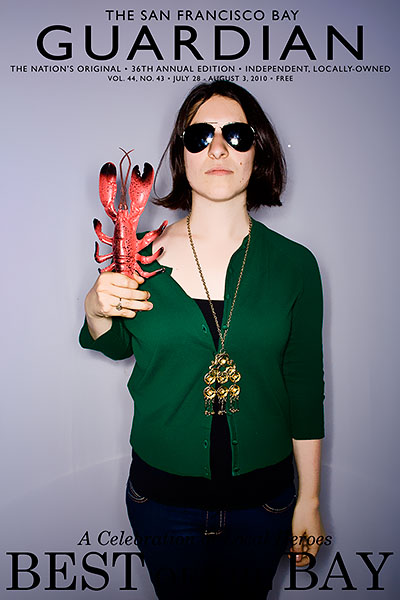
There is nothing quite like a little forced introspection to make you sit down and realize that you’ve had one of the most jam-packed years of your life. (Literally, lots of jam.) In this case, a competition — Foodbuzz’s Project Food Blog is the name of the game. Their first challenge requires me to define why I should be the Next Food Blog Star. Perhaps I should start be re-introducing myself to them, and to you.
I’m Samantha. And I love food.
Two years ago I needed a change of scenery and decided to move three thousand miles from the comfort of New Hampshire to bustling San Francisco. To be honest, this decision was probably made years earlier when I first watched the film Mrs. Doubtfire. Few things live up to the wide eyed optimism of a seven year old, but San Francisco held up its end of the bargain. I love it here.
Continuing with the spirit of reinventing myself, I started a food blog upon my arrival.
Little did I know where it would lead me. Shortly after joining Foodbuzz, I participated in Foodbuzz 24,24,24 and got an amazing dream meal at chef Chris Cosentino’s Incanto. This connected me to an internship at a Food P.R. firm. I started working with chefs and restaurants on recipe organization, development and testing, and fell in love with all the hard work behind creating a dining experience. Okay, truthfully this love started when I became a stagiere in a local restaurant at the age of 12.
Somewhere along the line I also became the research assistant and recipe tester on a cookbook by “Jam it, Pickle it, Cure it” author Karen Solomon (see, lots of jam). I became involved (re: obsessed) with Omnivore Books on Food, and eventually ended up pretty much moving in, thanks to Celia Sack offering me a mercy job. All the while, I took control of my own health, got back into shape, and I went back to school at Integrative Nutrition to become a Health Coach and help others do the same.
And for the sake of full disclosure, I should confess the number of cookbooks I own now well exceeds the bookshelves I own to store them.
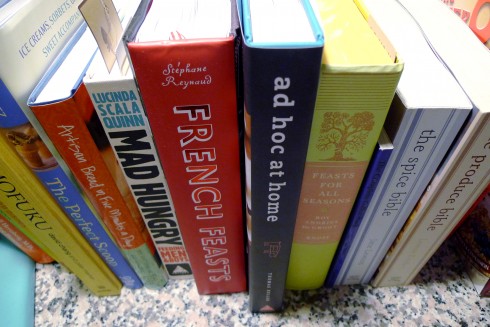
Why do I blog you may ask?
Ultimately, it comes down to the people I get to meet and be truly inspired by. For me, food blogging is not just about the chow, but integrally about those who are a part of it. I realized early on I wanted to share their stories with you. And in many ways, that’s what The Second Lunch has become.
In the past year, I’ve met so many wonderful chefs and insiders of the industry — I truly feel blessed for where my passion for food has led me. For this post, I decided to make a list of some of the folks I’d met, thinking that I’d get a good paragraph out of it. I did not expect this brick wall of superstars. This shocks me every time I glance down at it.
The short list includes: the wonderful folks from Big Sur Bakery, Polly Adema, Arthur Allen, Nate Appleman, Rose Levy Beranbaum, Ed Behr, Amy Besa, John Besh, Carole Bloom, Mark Bittman, Kim Boyce, Bruce & Eric Bromberg, Frank Bruni, Novella Carpenter, Mark Stewart Cassidy, David Chang, Nan Chase, Anita Chu, Andrew Coe, Langdon Cook, Chris Cosentino, Temra Costa, Elizabeth Crawford, Dave Cruz, Tod Davies, Penny De Los Santos,Tracy Des Jardins, Elan Drucker and Brett Emerson, Tara Duggan, Gordon Edgar, Elizabeth Falkner, Sarah Max Feldner, Jeremy Fox, Zoe Francois & Dr. Jeff Hertzberg, Fran Gage, Marcia Gagliardi, Anna Getty, Barbara Ghazarian, Darra Goldstein, Evan Goldstein, Joyce Goldstein, William Grimes, Giuliano Hazan, Dierdre Heeken and Caleb Barber, Jaden Hair, Pauli Halstead, Gerald Hirigoyen, Fergus Henderson, Lauren Hoover, Dianne Jacob, Madhur Jaffrey, Michael Kalanty, Niloufer Ichaporia King, Thomas Keller, Shelly Lindgren, David Lebovitz, Matt Lewis & Renato Poliafito of Baked, Barbara Lynch, Kermit Lynch, Deborah Madison, Jacqueline Mallorca, Harold McGee, Nancy Mehagian, Dr. Daphne Miller, Kate Moses, Marion Nestle, Cynthia Nims, Andrea Nguyen, Barbara Passino, Greg Patent, Cindy Pawlcyn, Georgia Pellegrini, James Peterson, Gayle Pirie, Michael Pollan, Michael Recchiuti, Peter Reinhart, John Relihan, Sara Remington, Tori Ritchie, Chad Robertson & Liz Pruitt, Lorna Sass, Rachel Saunders, Jennie Schacht, Lisa Schwartz, Kim Severson, Andrew Smith, Karen Solomon, Andrew Swallow, Heidi Swanson, Michael Symon, David Tanis, Pim Techamuanvivit, Corinne Trang, Patricia Unterman, Alice Waters, Max Watman, Tara Austen Weaver, Bruce Weinstein & Mark Scarbrough, Ari Weinzweig, Joanne Weir, Laura Werlin, Kathy Wiley, Victoria Wise, Molly Wizenberg, Paula Wolfert, Scott Youkilis, Grace Young, and Jane Ziegelman – Not to mention the hundreds of other food lovers that I’ve had the pleasure to meet over the past two years. (They would fill another post in itself). And I already know I’m forgetting some wonderful people on this list.
And that’s only in the past year. In the next month I’m going to add Rene Redzepi, Tyler Florence, Michael Chiarello, Dorie Greenspan, Jordan McKay, and Diana Kennedy to that list. And who knows who else?
* * *
Just incase you need another reason to push me onto the next round, here are several awkward and embarrassing photos from my childhood revolving around food. From top left: The taste tester, baking cookies with Sarah and Sara, hugging the Mauna Loa Macadamia Nut, and picking apples from a tree.
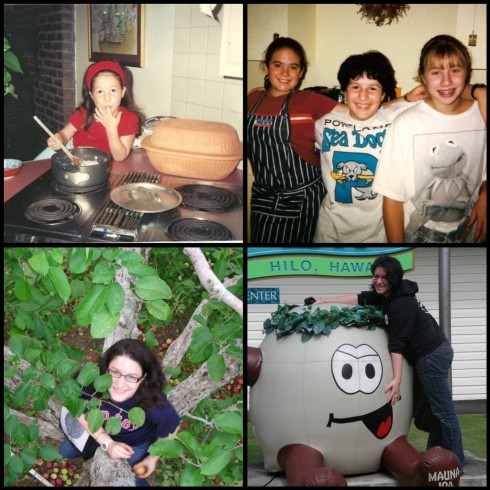
Mostly though, I blog because I love it here. I love being part of a greater community who cares just as much as I do, and doesn’t bat an eye when I whip out a camera at dinner and debate the origin of our meal with my dining companions, purchase another cookbook I don’t have space for because I don’t want to deprive myself of knowledge, wait an hour in line for crispy pork skin because well, it’s crispy pork skin, or wade through thousands of hungry hippies at the farmers market for the perfect summer peach.
Yes, my name is Samantha and I love food.
But equally, I love everything that surrounds it.
by Sam Tackeff | Sep 14, 2010 | Gifts, Liquor, Mixed Drinks, Shopping

Scotch is classy.
Scotch is a man’s drink.
Scotch is, in fact, such a classy man’s drink that George Clooney is selling it to the Koreans.
I am neither a man, nor very classy (well, I do try sometimes). But, I love my liquor, and I feel a special kinship with Scotch Whisky that’s been years in the making.
My relationship with Scotch began, of all places, in a lab. A college geology lab, after dark, to be specific. In class we were learning about peat bogs, and someone decided to toast the 9,000 year old perfectly preserved peat bog man with some extra "peat-y" Scotch in his honor. And we may or may not have been taking part in this ritual while watching a Nova special about it at the time. It’s called "The Perfect Corpse" if you are curious.
 (Photo of the peat bog man: Lonely Planet Images)
(Photo of the peat bog man: Lonely Planet Images)
And, yes, I’m a nerd. But I kept good company, as a love of food and drink is typical of geologists, really scientists in general- in our lab we made good use of a cappuccino machine, and conversations that weren’t about albite twinning and plagioclase feldspar tended to be about our last meal, or perhaps our next one, or the one after that.
I’ve always found the link between science and food to run deep, even historically so – perhaps nothing will light a candle to the rumor that a defrosted Mammoth was served in the late 1800’s at a Royal Geological Society annual gathering. That, is food obsession at it’s best. (And no, I can’t substantiate that rumor, but I heard it once in a Paleo lecture.)

To the point:
When Victoria called us to schedule a Scotch tasting with Mark Stewart Cassidy at Omnivore, and promised me that a man in a kilt with a Scottish brogue would show up, be handsome, and teach us a little more about traditional Scotch whisky, I was a little beside myself. At the event, after drinking three generous samples of scotch, my feverish notes did become slightly less legible, but I’ve spent significant time deciphering them for the purposes of education about this finest of libations.
[For the record, Whisky = Scottish English, Whiskey = Irish English, and yes, I had to look it up.]
And so, for your entertainment, and mine, here I give 2 minutes for Scotch. This is by no means a thorough discussion, but perhaps a starting point for your own adventures. I digress.

Although Whisky has been made in Scotland for hundreds of years, Scotch became popular in part because of the Phylloxera bug wiping out the cognac and wine making production in France in the late 1800s. While drinking entire handles (do we call them handles?) of Scotch now seems to be a little excessive, to put it in perspective, Churchill was said to have drunk a bucket of brandy a day. What else would be better "after [a day of] shootin’ fishin’ or flogging peasants?"
What the heck is in this stuff, anyway?
Provided that the liquid is Made In Scotland some basic facts:
1. Essentially, Barley + Malt + Water = Scotch.
2. The cask to age the Scotch is always made of Oak. They usually are reused casks from making sherry or bourbon.
3. Evaporation occurs: The first year in the cask, 5% of the alcohol evaporates, and typically every year following an additional 2% evaporates. Some say because of this, the best value is at 10 years, (not necessarily the best taste), but at this point, it has aged, but not evaporated away.
4. Has to be at least 40% alcohol.
5. It is said that taste can be attributed 70% from the cask, 15% from the raw materials, and 15% from the production/skill of the distiller. That said, there is still mystery around what makes a perfect scotch. Every distillery has a master distiller, who’s entire job is to think about these things. There are stories about master distillers who "wouldn’t let anyone move cobwebs – [because] you don’t know what will effect the taste."

How to Taste Scotch:
1. Pour it: Leave whiskey in the glass for 1 minute for every year it has been in the cask.
2. Prepare it: Add a drop of water, down the side of the glass (as to not destroy the bouquet, and so the aroma stays intact). The water picks up the oils and helps to enhance aroma and flavor.
3. Think about it: when you drink scotch, take note of the nose, the body, and the finish.
There are five categories of Scotch: Single Malt, Blended Malt, Blended Scotch whisky, Blended Grain Whisky, and Single Grain Scotch Whisky. For this tasting, we sampled three varieties of Single Malt Scotch Whisky, each with their own distinct characteristics:

Scotch #1:
Highland Region, Aberfeldy 12 year ($39.50)
The first Scotch was the Aberfeldy, which I immediately enjoyed immensely because of the symbol on the bottle which appears to be a squirrel.
Aberfeldy is one of the distilleries that contributes to Dewars’, a particularly well known Scotch brand. Dewars was one of the first Scotch brands sold in a glass bottle with a label, and holds it’s own in the Scotch arena today –– In fact, about five blending houses own all the distilleries in Scotland.
Taking my first sip of the Scotch – HOO-AH – I had forgotten the kick this stuff can give! The bite goes away relatively quickly, the same way a properly spiced dish may give you an initial punch, and then settle down as to not torture you for hours.
During tasting we noted that there is no peat taste, because in the Highlands they mostly use coal to dry the barley. According to the master, there were also vanillins, traces of copper, and peroxide in the flavors.

Scotch #2:
Speyside Region, Benromach Organic ($85.00)
By far and away my favorite. This Scotch was unique because it was the worlds first certified Organic single malt. While Organics have taken their time to become a standard in the alcohol industry, the flavors of the highest quality ingredients grown in clean soil really make this Scotch stand out.
It was crisp and light, with a quick burn, and satisfying lingering sweet and spicy notes. And well, perhaps I’m just going crazy, but for some reason, I noted a hint of coconut which put me in a tropical mood.

Scotch #3:
Island Region, Highland Park 12 year ($45.00)
The final tasting was the Highland Park. Which evoked daydreams of sipping the stuff on the lawn of a big castle, playing cards, and smoking cigars. Maybe with Robin Williams in golf attire in the background.
Perhaps the most like what people traditionally think of when they think of Scotch, this was an example of Peat whiskey, given it’s distinctive taste of drying the barley over peat. ( I got to admit, everyone loved it, and I think it tastes like drinking from a bog. A pleasant bog, but bog none the less.)
In summary, who knew that my favorite would end up being the $85 dollar bottle that I can’t actually afford to plunk down the cash for? Well, if anyone would like to remedy that ––
Scotch available at:
The Whisky Shop | 360 Sutter Street | San Francisco |415.989.1030
The question becomes, where do I go next? Invariably there will be actual Scotch fanatics reading this, and by all means add to the conversation – do you have a favorite type of Scotch?
by Sam Tackeff | Aug 19, 2010 | Asian, Books, omnivore books, Restaurants
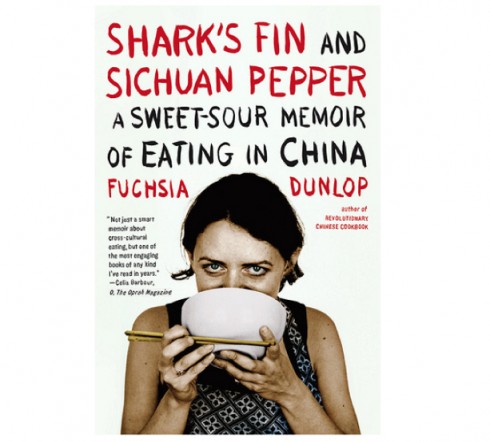
Summer isn’t over yet! (Really, it’s just beginning here in San Francisco). For anyone looking for some good summer food reading – look no further! There is still time to hit the beaches and don your sunhat with a good book! Here is the official Omnivore Books Summer Reading List – for those of you who haven’t seen the newsletter – here is the list (I have in fact, read every single one of these books, and enjoyed them myself):
OMNIVORE’S 2010 BEACH READS
By far, one of my favorite books on this list is Fuchsia Dunlop’s ‘Shark’s Fin and Sichuan Pepper: A Sweet-Sour Memoir of Eating in China‘. Perhaps I’m biased because one of my oldest childhood friends lives in Shanghai, and I feel a kinship to those who write about China, and perhaps my bias extends from my love of Chinese food instilled from my father’s very good Chinese cooking skills (he learned from an Asian grandmother whom he exchanged grocery shopping for her for cooking lessons), but nevertheless there is something visceral that comes up every time I get to recommend this book to someone.
When people come into Omnivore asking for their next good read, I usually direct them towards this book and start waxing poetic and verging on desperation. You MUST read this book. I’m not sure how I would even describe this woman without babbling about how cool she is and how much I admire her tenacity and how much I want to be like her. Here I am doing it again.
Above all, I love reading books by smart, motivated, strong women. There, I said it. Some of my biggest role models are writers such as M.F.K. Fisher, Elizabeth David, and Judith Jones. These women inspire me every day. In brief, Fuchsia Dunlop is certainly one of these women I admire: a witty and persistent Englishwoman, who rather than taking the safe and comfortable route, decided to study abroad in China during her University years. People just didn’t do that in the 90’s. Her brief stint led to a lifelong passion – she went back to live there, and ultimately managed to stumble her way into becoming the first westerner ever to attend the Sichuan Institute of Higher Cuisine.
Ultimately she went on to write two cookbooks, ‘Land of Plenty: A Treasury of Authentic Sichuan Cooking‘ and the ‘Revolutionary Chinese Cookbook: Recipes from Hunan Province‘ which are both excellent resources for Sichuan and Hunanese cooking. Beyond the cookbooks, it was a good thing she went ahead and wrote her memoir. Her voice on the page is clearly one of a woman I’d love to go gallivanting off to the ends of the earth with.
Throughout the book, Dunlop has this wonderful way of describing the tastes and the essence of food, and ‘Shark’s Fin and Sichuan Pepper: A Sweet-Sour Memoir of Eating in China‘ is full of amazing, bizarre, and sometimes even shocking tales. I found myself reading through this book – giggling, getting hungry, and experiencing her remarkable journey as a vicarious travel partner.
The Bottom Line: I highly recommend this book.
And then, of course, once you read it, you too can join the ‘Fuchsia Dunlop Admiration Society’ (OK, so I made that up) and can follow her on twitter! Now if only we could get her to come on vacation and speak at Omnivore! We’ll have a party!
* * *
And now, while we are on the topic, here are a few photos from a dinner I had with fellow food bloggers quite some time ago at Sichuan restaurant Z+Y in San Francisco’s Chinatown. Totally Authentic? Not quite, but it was delicious nonetheless.
I’ve had a soft spot for Sichuan since I was a child, mostly because one of the better Chinese restaurants in our slightly sleepy corner of New Hampshire was called Szechuan Taste. There was one in Portsmouth, and then they opened another one in Exeter conveniently located blocks away from my high school. I can’t really vouch for the authenticity of the food, as they became very Americanized over the years, but I loved the place and have fond memories that guided my pursuit of knowledge into Chinese cooking, so I have to give them credit where credit is due.
At Z+ Y, we ate (somewhat gluttonously, between eight of us): Scallion Pancakes, Spicy Numbing Beef Tendon, Yunnan Style Steamed Chicken Soup in Clay Pot, Peking Duck, Pea Sprouts with Garlic, Special Pork Belly (not on the menu), Chicken with Explosive Chili Peppers and Hot Braised Sea Bass, Cured Beef Wrapped In Scallion Pancake, and Red Bean Buns for dessert.
There is something really reassuring about eating dinner with food bloggers. For one, you don’t have to feel any embarrassment about taking photos of the food, and really the phrase “WAIT – let me just snap a few photos please!” even remains unsaid. Although, to be fair, Devon is very good about waiting patiently for me to take my photos at dinner.
Bloggers in attendance: @cookingwithamy @chefjen, @urbanstomach, @summertomato, @alphaprep (yep that’s me), @divinacucina, @heatherhal and @Jeters.
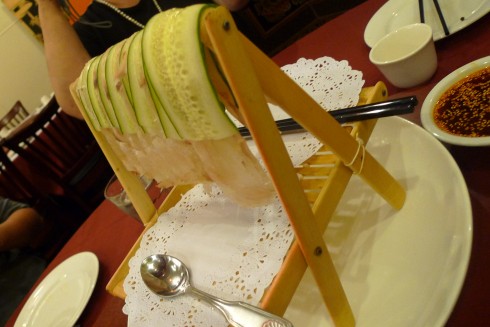
Another thing about eating with food bloggers is that you can order half of the menu and not skip over the bits and pieces of the animal for fear that your dining partners will not be so keen on your choice. And so here, a dish that we all (or mostly all) enjoyed: Tendon. It’s not just for pho! I can’t get over the fact that it looks like I’m being served food on an easel. I really got a kick out of this dish. The beef tendon was shaved thinly, and served with a tingly numbing sauce.
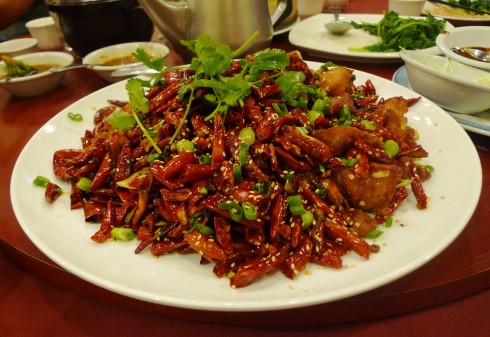
We food bloggers also really appreciate highly photogenic foods, such as this Chicken with Explosive Chili Peppers. Massive piles of fiery peppers in contrasting red and green! I’m fairly sure this had more peppers than would be needed or wanted in the home, but it made for an exciting presentation.
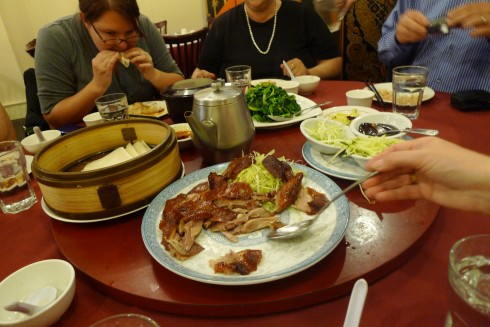
And then there was the duck. Apologies to @jeters for the “in the moment eating shot”, but I had to put this in as it was the only shot of the duck I managed to take. I’ve been a devotee of duck since my childhood where my favorite memories of Chinatown were the ducks hanging in the windows. I’m sure my parents were slightly concerned about my excitement – I was at that point fully aware of the live happy farm duck being the same, in theory, as the dessicated hanging duck in the window – and I still would ask to eat it pleadingly.
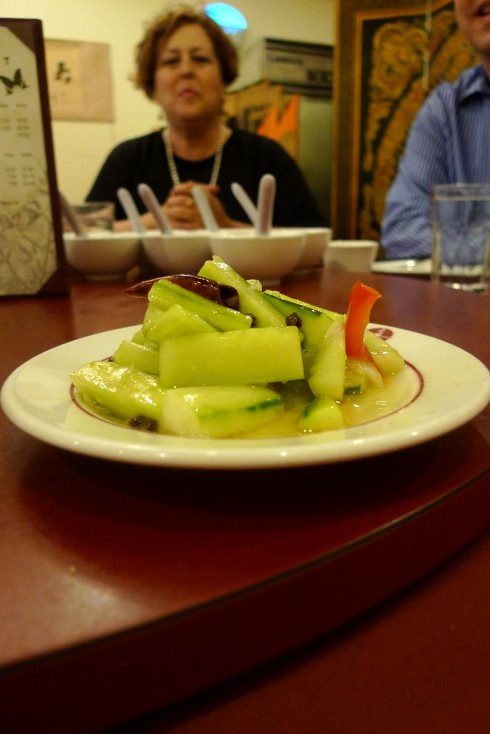
A great part about the food blogging community is that you can eat with people that you greatly respect and admire, and even if their work is heralded across the globe, perhaps in bookstores, or written about in famous magazines, even the best food writers will gather to share a meal – food is something we all have in common. The lovely and talented Divina Cucina in the background (for whom this dinner was in honor of), and quick pickled cucumbers in the foreground.
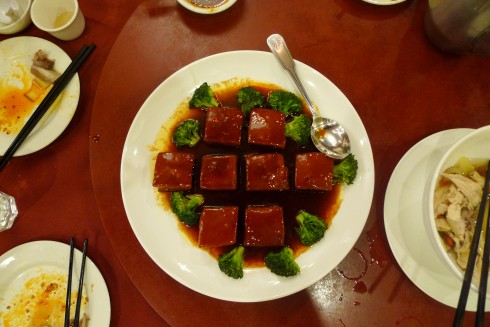
Food bloggers also have gumption and forethought to order in advance, and throw their hands into the air and say feed me the best you can! The Japanese have a word Omakase, or Chef’s Tasting Menu, that is in the spirit that I like to eat – allowing the chef to choose the best, the freshest, the most interesting foods, and as a rule, I always defer to their suggestions for which I’m often highly rewarded. The pork belly – not on the menu, but at the recommendation of the chef was delightful – a current food trend, pork belly has been a delicacy for hundreds, if not thousands? of years, and prepared simply, this was one of the better experiences with pork belly I have had to date.
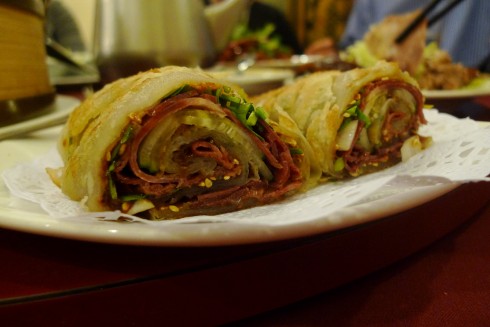
And then there is that moment in many a meal, where sometimes, even seasoned food bloggers are slightly perplexed. In this case, the moment was when we were served the cured meat wrapped in scallion pancake – Chinese-Jewish fusion food? I wasn’t able to grasp the influence, but I liked it!
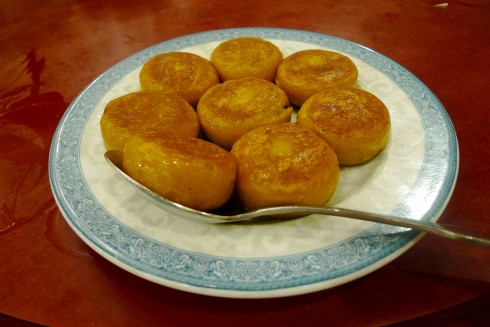
Finally, we ended with red bean buns, and slices of orange, which, although I do have some fabulous photos of friends making awkward orange smiles, I’ve held back at posting them, perhaps though, they’ll serve as future blackmail.
For more perspective, check out Alex’s write-up (same dinner, lens across the table). And for even more convincing, Marcia (The Tablehopper) also had a great writeup of her dinner a month ago.
Z&Y Restaurant, 655 Jackson St, between Grant & Kearny
415-981-8988
Monday-Sunday 11 AM-10 PM
Pre-Ordered Nine Course Meal For Eight: $200 after tax and tip (sans beverage)
by Sam Tackeff | Jul 17, 2010 | Baking, Challenge, omnivore books
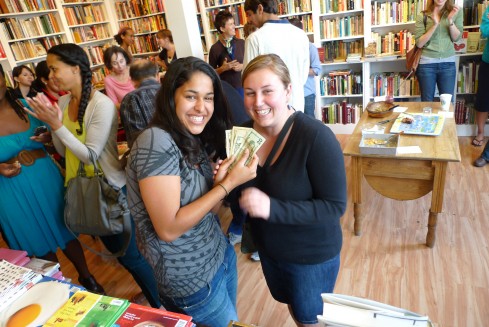
Another smiling shot of the winners (Aleta and Lilly) of an Omnivore Books Food Contest. This challenge: Stone Fruits. The entries were all diverse (okay, except maybe for a noticeable trend of peaches) and everything was delicious. Despite my resolution to keep my tastes to a minimum, I end up trying everything, and eventually went back to seconds. Damn deliciousness breaking my willpower…Here are all photos of all of them to drool over.
The winning dish?
An Assortment of Galettes. These charming galettes were the clear favorite. Excellent dough, and creative fillings. The dough was a
Pâte à Foncer dough from ‘Advanced Bread and Pastry A Professional Approach’ written by Michel Suas. I’ve attached the recipe at the bottom – perfect for summer baking!
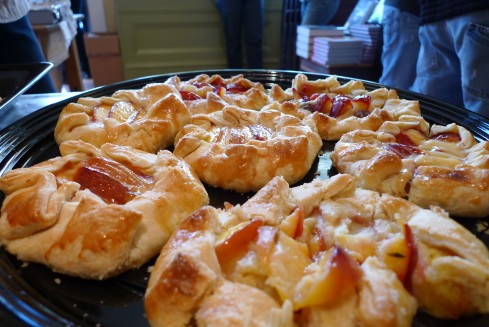
The runner up was Lisa’s individual Financiers with Peaches, Almonds, and ‘lotsa Butter! Let me just say that these were some of my favorites – I’m a sucker for classic french pastries.
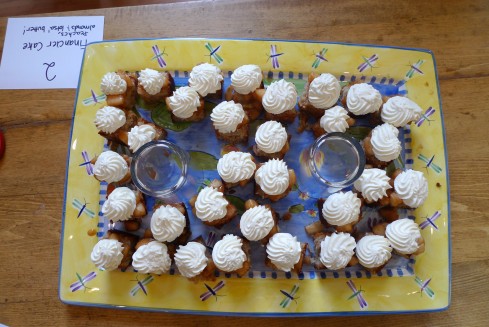
Our own Paula brought a lovely Peach Cobbler, which had the glorious addition of a little bit of almond extract, that I must remember to add to my own. It’s a wonderful marriage of flavors.

A savory Peach and Nectarine Salsa was served with chips in this absolutely adorable vintage serving dish. I’d like to get one of these! The salsa was incredible, but the entire presentation was a feast for the eyes. I can see bringing this to every summer cookout.
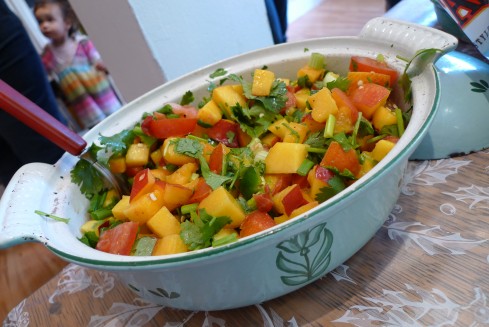
A Two Plum and Peach Pie was served elegantly on a raised platter (points in my book for presentation), and I loved particularly the way the plums were treated – they had an intense flavor.
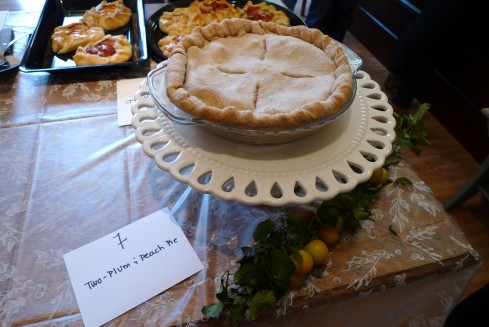
A jar of plum jam. Sweet and to the point. I could see this being consumed very quickly in my house, probably equally on toast and stirred into a morning yogurt parfait.
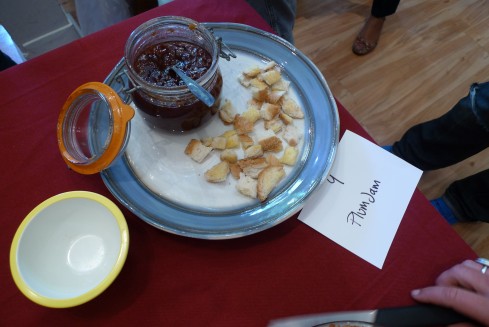
Peach and Nectarine Pie – quite a classic pie, with nice addition of cutout circles of dough adorning the top of the pie there.
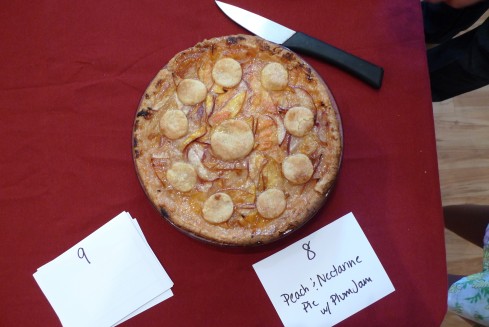
Apricot Clafoutis – one of my favorite French desserts. And so easy to make! This version with Apricots was lovely. (The chef also recommends chocolate and cherry clafoutis. I think I’d have to second that – maybe it will be my next baking project.)
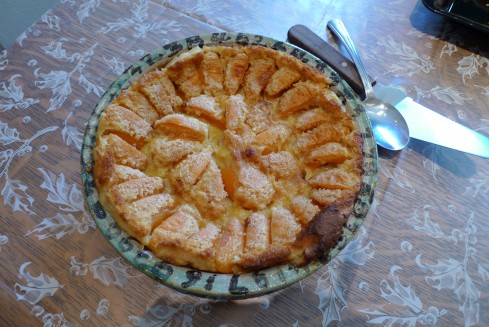
Italian Pistachio Plum Cake (and it was vegan!) – a delightful, almost spongy (in a good way!) pistachio cake dotted with the perfect little plums. And it came with a delicious jam (with an extendable spoon to boot – making for the perfect competition servingware) .
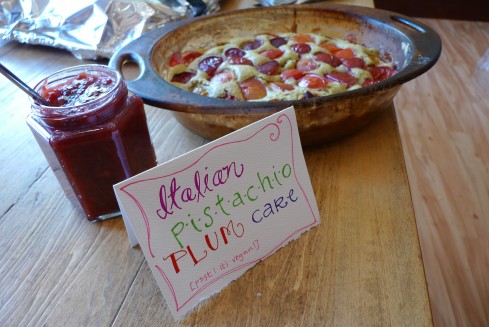
Savory Plum Tarts – the last entries into the competition, a little late but they certainly held their own! Came in two flavors – one with thyme, rosemary and lavender jam, and the other with basil, honey, and balsamic.
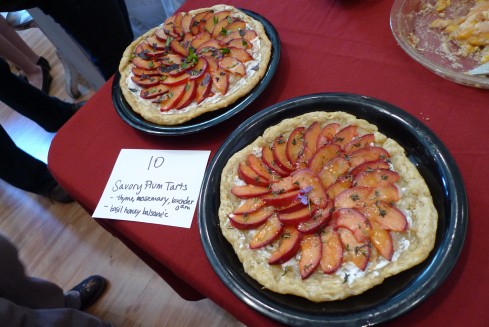
Jealous?
Don’t worry! We have another contest coming up next month: Tomatoes!
Tomato Cooking Contest! Omnivore Books – August 14th – 4-5pm. Bring a tomato dish, sweet or savory, or just come to eat with $5 dollars in hand ready to judge your favorites. Winners split the door money and earn serious bragging rights.
* * *
Pâte à Foncer
from ‘Advanced Bread and Pastry A Professional Approach‘ written by Michel Suas
Don’t be put off by the metric measurements – baking in metric is much more precise and yields better results. And it’s incredibly easy to find a kitchen scale – mine that tares from metric to standard US I purchased at Ikea for about $12.
yields about 6-7 5inch galettes
Ingredients:
395 grams Pastry Flour
296 grams Butter
79 grams Milk
16 grams Egg Yolks
8 grams Salt
6 grams Sugar
Method:
1. Preheat oven to 425ºF along with a sheet pan or pizza stone (385ºF for convection oven).
2. Allow butter, milk, and egg yolks to come up to room temperature. Butter should be almost mayonnaise consistency.
3. Soften the butter and mix with the paddle attachment.
4. Add the salt, sugar, yolks, and milk, and then add the flour. Mix until just incorporated; dough should look a little bit shaggy.
5. Refridgerate dough for 1 to 4 hours.
6. Divide dough into 7 pieces. Roll dough out to about an 1/8 of an inch thick about 6-7 inch rounds. Fill with either sweet or savory filling. Egg wash crust.
7. Bake until golden about 25-35 minutes.




































